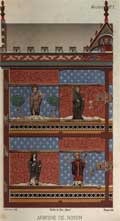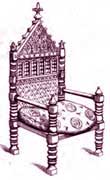Gothic Furniture
At its debut, the Gothic furniture was marked by simplicity, with a robust looking. Those pieces meant to keep valuables had to give the assurance of a well locked, secure place. Eventually, the Gothic furniture adopted the refinement of the Cathedral ornaments.
Up to the 14th century, the Gothic style furniture was decorated mainly with paintings. Towards the end of the century, the sculpted ornaments became more prominent.
Gothic church furniture
One of the finest examples of the Gothic period furniture is the cabinet in the treasury of the Cathedral of Noyon, dating from the end of the 13th century. It represents the painted Gothic furniture at its best.

Cabinet Detail
Noyon Cathedral Treasury
All the panels are beautifully painted both inside and outside, and the upper part is richly decorated with sculptures. The side panels are displaying v-shapes painted in white and yellow. Most probably, the cabinet was used to store utensils used in the religious service. In the Medieval churches treasuries there were also portable cabinets, used to keep precious relics.
Gothic castle furniture
Castles belonged to the upper class, so the furniture was of better quality, and in a higher number then in ordinary houses.
Gothic chairsThe chairs were highly praised pieces of Gothic furniture. Because they were more attached to personal use, their precious fabrics were meant to match the richness of their owners' clothes. For quite a while, in each room of the feudal residences there was only a chair, that of the feudal lord, while the other persons were using benches, or flat chests.
In the 12th century, the chairs were either rectangular, with a low back and legs continuing above the seat, or circular, with the back of the same height as the armrest. In the 13th century, the polygonal shape became characteristic for the "chairs of honor" reserved to the lords.
The Gothic style chairs followed the evolution of fashion, their shape adapting to the new clothing styles. Enriched with sculptures, they became heavier and larger. The chairs installed in the main hall of the castle became similar to the royal thrones.
Gothic bedsGothic beds began to gain in luxury starting with the 12th century. They had refined ornaments, sculpted or painted, with mattresses and blankets richly embroidered. The bed curtains were attached to transversal beams, with or without a canopy.
In the 14th century, the wooden part of the bed began to be hidden by curtains, while the ornamented bed head became higher. Especially in the princes' residences, beds were draped by precious fabrics, heavily embroidered with gold threads. The 15th century added to the luxury of mattresses and blankets.

Gothic Style Furniture
Domestic chair
The Gothic tables were usually rectangular. In the grand hall of the castles sometimes there were ornamental, sculpted tables, made of stone or marble. The rich often had tables made of bronze, silver or gold. It was the custom for lords and kings to use a separate table to eat, thus these tables were long and narrow.
Gothic chestsThe chests were initially meant to be used for travel, but later they became a fixed piece of the Gothic interior. In the Middle Ages there was no room without its own chest. In the 13th century, the craftsmen started to extensively use the "cathedral" style of ornamentation, consisting of motifs like the tracery, trefoil, quatrefoil. The splendid chests were decorated with elaborated sculptures, their panels having a strong architectural character.
Other Gothic furniture pieces were the sculpted benches, with a shape close to the modern bench. Sometimes they could serve a dual purpose, resembling a flattened, long chest.
Gothic domestic furniture
The cabinet was the main piece of domestic furniture. It was more prominent due to its relative luxury, even in the peasants' houses. It was the treasury of the family, where silver, savings, and official papers were kept. Throughout the Middle Ages it remained the most important part of the family furniture.
The domestic chairs, decorated with "flat" sculptures (sculptures indented only 2-3 mm in depth), resembled more our modern chairs, having mostly a high back.
The chest was another important piece of domestic Gothic furniture, together with the cabinet and the bed. In the beginning, the chests were simple, sometimes decorated with paintings. Later, they were enriched with sculptures, their evolution following that of the cabinets.
With its exquisite ornamentation, adopting the architectural forms of the time, the Gothic furniture constitutes another form of expression of what we call Gothic Art.
